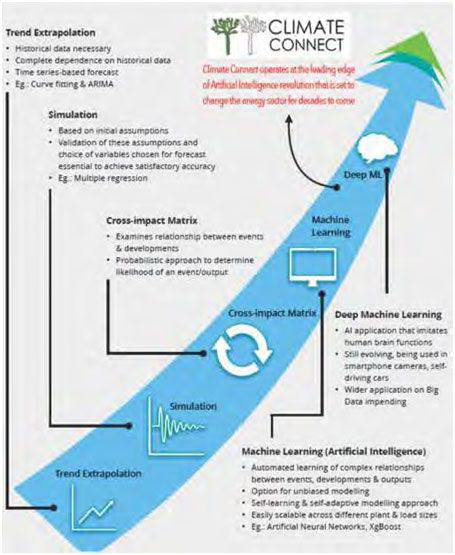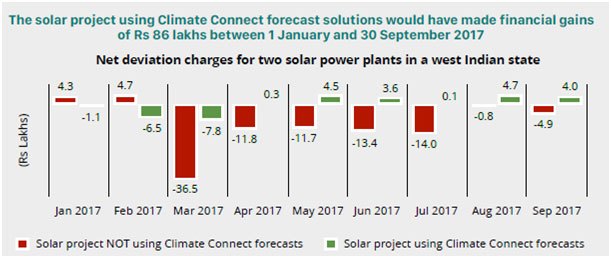Climate Connect: Bridging the gap in Utilities

Role of AI and ML help in bridging the gap in utilities sector as the industry shifts from fossils to renewables.
Introduction
As the energy and utilities industry is trying to figure out ways to shift from traditional fossil fuel to green and renewable sources, it is facing various challenges. One of the main differences between these two sources of energy, is the degree of unpredictability in power generation and distribution. In comparison to the traditional sources of energy, the renewables (solar and wind) have a much higher degree of unpredictability in power generation especially due to factors like weather – sunshine and wind. In addition, renewables today are supporting thermal power plants and are therefore scaled up or down according to the unmet demand. What we envisage in near future is the other way around – with renewables as the main source, fossil fuels should be supplementing the unmet demand (till we become 100% reliable on renewable sources). These challenges therefore pose a serious gap between demand (power distribution) and supply (power generation).
Climate Connect deploying AI and ML
London-based Indian energy start-up, Climate Connect is trying to bridge this gap by deploying artificial intelligence (AI) and machine learning software at generation, transmission and distribution projects for its clients with a total of 20 gigawatts (GW)[1].
The start-up uses AI algorithms built based on millions of past hourly data points from the transmission system, distribution network, generation types, and weather models to offer real-time intraday, day-ahead, term-ahead, and long-term energy forecasts. It also forecasts market prices and bid volumes, to predict power prices. The company’s aim is to use technology to make renewable energy affordable to the masses[3].
Power Distribution
One of the main problems in developing countries like India is load-shedding and the reason is the inability to forecast power demand accurately. Power distribution companies must know in advance how much power it needs the following day, while making intraday predictions, which depends largely on weather conditions. For instance, on a hot day, more people will turn on their ACs, but if it rains, there will be less power usage. Traditionally power distribution companies relied on manual calculations everyday but with Climate Connect’s machine learning software, they can look at real time and historical data on usage and weather patterns and make more informed decisions on how much power they will need to provide on a given day.
Power Generation
On the generation side, solar energy companies, for instance, need to know how much power they will be able to generate on a day, since power generation from solar panels are directly dependent on weather patterns and irradiation levels. Earlier, generation companies worked with excel sheets on weather patterns and made crude estimates. Now, with machine learning systems applied to solar generation, a company can make these predictions better. As a result, penalties that these companies paid to a grid operator for generating less energy than what they had committed to, have come down by 80%.” After the first year of deployment, penalties came down by a further 30%, he added [1].
Vision, Challenges and Recommendations
Career Connect wants to revolutionize the industry with ML and AI and has a vision for a 100% renewable power grid. They want to expand their current reach of 20GW to 300 GW soon [3] by expanding their services to China and the US. Though it seems to be a booming business model in the nest 5 years or so, but my first challenge is weather machine learning can expand its reach from day-to-day predictability to long term planning for helping power distributors and generators evaluate their long term projects and bid a fair price. And the second challenge is scaling while facing competition. Data analytics is a part of every company now and soon machine learning will be. This sector is facing immense competition and how should Climate Connect maintain its competitive advantage?
My recommendation to them will be to use Artificial intelligence and Machine learning to help plan long term projects with their clients. This will have a two-fold benefit. One, they will assist their clients with a project financing and management tool (up from only a predictability tool) and second this will give them a competitive advantage that will help them scale and grow across the globe.
In addition to the above questions, there is another question that occupies my mind space:
Currently, all the big power generation and distribution companies are willing to share their data with companies like Climate Connect but they soon won’t, when machine learning will become so common that every small company can have it in-house. At that time, how will companies like Climate Connect (who are the pioneers in the field) will survive and how will operator companies leverage a large data pool?
Words: 782
References:
- https://search-proquest-com.ezp-prod1.hul.harvard.edu/businesspremium/docview/2073060577/D10A5726D5784B80PQ/3?accountid=11311
- http://www.energetica-india.net/articles/the-advent-of-artificial-intelligence-in-indias-power-sector
- https://www.climate-connect.com/about-us.php
- https://www.infosys.com/human-amplification/Documents/energy-utilities-ai-perspective.pdf
- https://www.engerati.com/article/smart-grid-progresses-india
- https://search-proquest-com.ezp-prod1.hul.harvard.edu/businesspremium/docview/2092807541/D10A5726D5784B80PQ/1?accountid=11311





I was really intrigued by your question relating to how companies like Climate Connect will survive if generation/distribution companies are no longer willing to share their data. Two things immediately jumped to mind (both of which are pretty flimsy, but presented for arugment’s sake):
(1) while companies may have some incentives to refuse to share their own data, that really only helps them if the past within their footprint is entirely predictive of their future in that region. In the case of rare events (i.e. extreme weather), global warming, or changing demand trends (i.e. developing nations) I could envision scenarios where my region may be evolving, but that new behaviour could be remarkably similar to what another region has experienced previously… for me to leverage their data, I probably need to contribute my own data to the collective pool.
(2) utilities sectors are heavily regulated in many countries, and they may be able to make an appeal to the governments/regulators that this data is crucial for efficient markets and/or in the best interest of the end-consumer
The ability to predict power demand and match it to power supply is essential to the power industry, and Climate Connect’s business model is an interesting new way to approach this challenge. Previously, demand response companies like Johnson Controls (1) have served to address this gap for individual building owners but actively managing and arbitraging the mismatch between that building’s power demand and the cost of the power from the grid (which is determined by the supply/demand gap at the grid level). However, Climate Connect’s model would essentially eliminate the need for a company like Johnson Controls, but moving the management of power resources up to the grid level. Working in concert with battery storage technologies, AI like of Climate Connect would greatly facilitate the move to a 100% renewable world.
Regarding the concern about continued data sharing if companies build their own equivalent of Climate Connect technology in-house, I would argue that Climate Connect would be in a great position because they would be an attractive acquisition target for strategic companies such as utilities or grid operators who don’t want to have to build this technology themselves from the bottom up.
(1) https://www.johnsoncontrols.com/en_in/buildings/services-and-support/energy-and-efficiency-services/demand-response
Especially given today’s challenges we are facing related to climate change – changing the predictability of weather forecasts and trends, and therefore to a large extend energy supply and demand – your essay is extremely relevant and gives a great insight into the latest developments.
I was surprised to learn how “crude” recent forecasting methods still were (i.e. as per your description based on excel models), so there seems to be a great opportunity to add value to this industry.
On your question, how companies like Climate Connect will survive facing a restricted access to data, I can see several solutions. One would be to find strategic partners that focus on big data collection and evaluation. Both partners could benefit from the partnership, complementing each other’s core capabilities.
Another option would be to provide a comprehensive, in-house “software as a service” solution to target companies, rather than only predictability or consulting services. Thanks to the nature of machine learning, I assume relevant players will not want to develop own IP in the space, but rather leverage an existing, proven system that benefits from having been applied over a longer time period with different data sets.